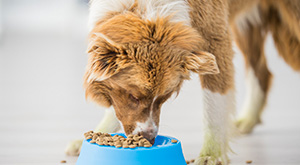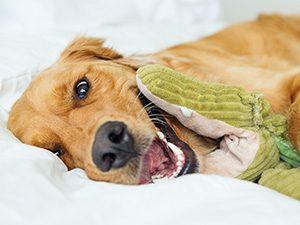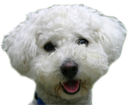Food Aggression and Resource Guarding
 You may occasionally find that your new dog may begin to show signs of aggression towards their food, water, toys, or other resources. Your family pet may develop aggressive and guarding behaviours over time as well. There are different methods for approaching how to treat this aggression, including training and obedience classes.
You may occasionally find that your new dog may begin to show signs of aggression towards their food, water, toys, or other resources. Your family pet may develop aggressive and guarding behaviours over time as well. There are different methods for approaching how to treat this aggression, including training and obedience classes.
What Is Food Aggression?
Food aggression in dogs is a defensive reaction to protect their food in the presence of a person, an animal, or both. Your pet may show this behaviour when guarding food in their bowl, food dropped on the floor, scraps in the garbage, or food being prepared on the counter. Over time, it can cause your dog to become possessive over all their belongings.
Food aggression comes as a natural instinct passed down through evolution when dogs needed to guard their meal in the wild. Young children living with dogs in a home may not recognize this behaviour and may ignore it completely. This could potentially result in a child being growled at or bitten. Sometimes, even adults may end up overlooking the behaviour. Aggressive dog training can address the issue and teach your pet to overcome their bad behaviour with their resources in different situations.
Causes of Food Aggression in Dogs
There are a few common causes of food aggression.
- A dog can learn this behaviour accidentally at a very young age.
- They can develop this behaviour in a sheltered environment where they need to compete over limited resources.
- Trauma such as losing their owner, physical abuse, fighting with another dog, or natural disasters are powerful triggers.
- Some breeds have hereditary aggressive tendencies and may guard food due to their pack-like mentality.
Common Signs of Food Aggression
Your pet may display varying levels of food aggression that are categorized into:
- Mild- It is best identified by verbal signs. Your dog may growl, bare their teeth, or raise their hackles when you approach their food or during mealtime.
- Moderate – It is characterized by actions such as snapping or lunging when a person or dog approaches them.
- Severe – It is the extreme behaviour your dog may show by biting or chasing someone away, which can be dangerous to people and other pets.
- Don’t Try Hand-Feeding as A Solution – Often, people attempt to interact with their dog while it’s eating in an attempt to reduce the aggression and guarding behaviours. This may include petting and touching the dog while they eat or hand feeding the dog. The owner assumes the dog feels comforted and associated their owner with positivity and meal time. In reality, the dog will tolerate or even enjoy their owner’s presence if they had no desire to guard their resources to begin with, so the exercise had no positive or negative effect. If, however, the dog does have a desire to protect their food, interacting with them while they eat will continue to be regarded as a stressful event, further causing the dog to become more defensive and view the human as a challenger for their meal.
- Do Not Punish Your Dog – By swatting or otherwise physically punishing your dog, you add fuel to the fire so to speak. They will perceive you as an aggressor and a more severe threat to their resources. This can also lead to insecurity in their general daily life as well. The more insecure they become around food and human beings, the further the aggression will begin to escalate to not just you, but others in your home including potentially children.
- Offer A Crate as A Safe Space – It is a good idea to introduce your dog to a crate shortly after bringing them home. The crate offers them a safe place to relax, play with a toy, have a treat, eat, or drink without feeling the need to protect their resources.
How to Stop Your Dog’s Food Aggression
Get Your Pet Used to Your Presence During Mealtime
Take advantage of your dog’s mealtime as the training time to reinforce appropriate behaviour. Ensure your pet establishes a positive association between your presence and their food. Stand a few feet away from your dog when eating food from a bowl on the floor. Your goal is to have your pet eat their food relaxed and confident for ten or more meals without showing any sign of aggression. This is the right time to move on to the next stage of aggressive dog training.
Fill Their Bowl with A Tasty Treat and Step Back
Add a tasty treat to your dog’s bowl and immediately take a step back to your position. Continue doing this each day while moving one step forward. Make sure you are consistent here. Dogs have a reliable internal clock, and with consistency, they quickly learn when it’s time to eat. If you can stand two feet away after putting the treat for ten meals without a break, you are ready to move to the next step of aggressive dog training.
Proper Training Can Help Reduce or Eliminate Aggression
 Here at Alpha Paws, we offer Basic Obedience classes as well as an Aggressive Dog Training program to help support the relationship between you and your dog. The programs not only encourage proper behavior overall, but also help with things such as establishing a command for disengaging. The command helps to prevent dogs from reverting to the defense mode they have hard-wired in their nature to protect or become aggressive over food or resources, whether towards humans or other pets in the home.
Here at Alpha Paws, we offer Basic Obedience classes as well as an Aggressive Dog Training program to help support the relationship between you and your dog. The programs not only encourage proper behavior overall, but also help with things such as establishing a command for disengaging. The command helps to prevent dogs from reverting to the defense mode they have hard-wired in their nature to protect or become aggressive over food or resources, whether towards humans or other pets in the home.
To enroll your dog in either our Basic Obedience classes or our Aggressive Dog Training programs, contact Alpha Paws today at 1-877-868-5248 (PAWS).
Also Read:



